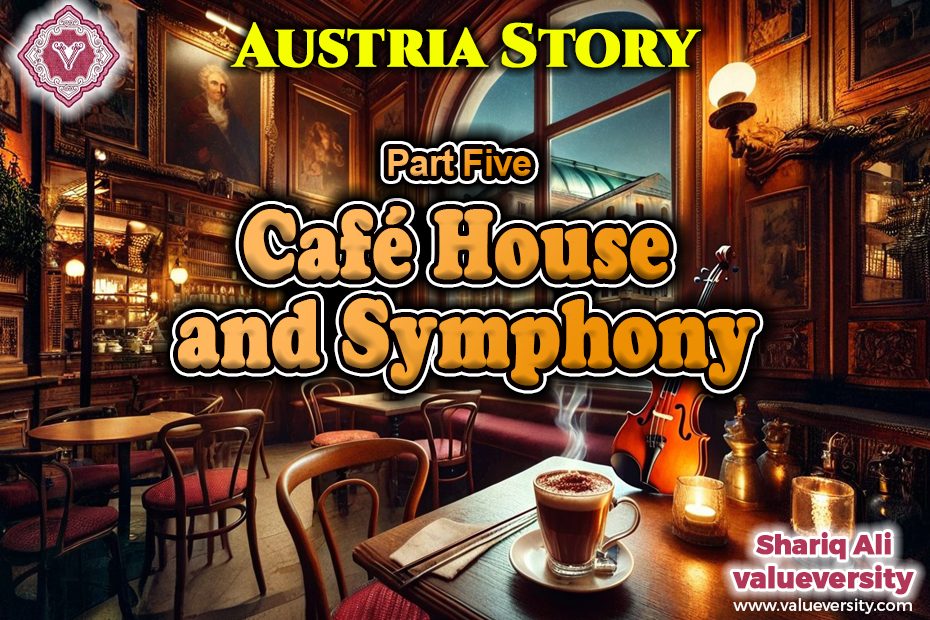Episode 5
By Shariq Ali
Valueversity
The famous restaurant in Vienna’s city center was bustling with activity. We had finished our dinner, but seeing the crowd, we decided not to wait for dessert. After making the payment, we stepped outside and took a deep breath of relief. Our destination was the State Opera House. Using Google Maps as our guide, we continued our walk. The night was pleasant, with a light chill accompanying the gentle breeze. As we walked through the busy streets and along the cobblestone alleys, we occasionally heard the melody of a violin or guitar played by a street performer.
After a hearty meal, we craved hot chocolate and also wanted to experience a traditional Viennese café house. A cultural journey through Vienna would be incomplete without visiting one. On a lively street, right in front of a zebra crossing, we spotted a small, traditional café. We pushed open the glass door and stepped inside.
Inside, it was a completely different world. The glass display cases were filled with colorful cakes, cookies, and other sweet delicacies. Behind the counter, enthusiastic, uniformed staff stood in front of various coffee dispensers—an image of modernity. After placing our order, we found a cozy corner to sit in, where tradition embraced us. Dim lighting, old wooden tables and chairs, vintage paintings on the walls, and the strong aroma of coffee lingering in the air. In the background, faintly audible, was a Mozart symphony—the entire atmosphere radiated an elegant and classical charm.
A gentleman was engrossed in a book, two individuals were immersed in their newspapers, and a small group of friends engaged in a hushed discussion.
Vienna’s café houses are not just places to sip tea or coffee; historically, they have been intellectual hubs for philosophers, artists, and thinkers. These were the very places where Sigmund Freud and the thinkers of the Vienna Circle refined their ideas. Here, they debated various theories, sipping coffee while shaping new currents in history. These cafés were not just about beverages; they pulsed with knowledge, literature, and the arts—a reason why UNESCO has recognized Vienna’s café culture as part of the world’s intangible cultural heritage.
After finishing our hot chocolate, we stepped outside. The night had grown even more enchanting. Every now and then, a faint musical note echoed through the air, as if the entire city was part of a grand symphony—
These were the very streets where Mozart and Beethoven once walked. Where they composed their timeless masterpieces, pieces still performed today in the world’s greatest opera houses and orchestras.
Even now, the Vienna Philharmonic Orchestra is regarded as one of the finest in the world. Every year, they perform the New Year’s Concert, watched by millions on television and in live audiences. Mozart’s former residence has become a pilgrimage site for music enthusiasts from all over the world.
Now, we stood right in front of the Vienna State Opera House. For a moment, its grandeur left us in awe. Bathed in golden lights, this opera house is one of Europe’s most magnificent cultural landmarks, renowned for its Neo-Renaissance architecture. The towering columns, intricate gold embellishments, high domed ceilings, and stunning architectural details made us feel like we were standing before a living masterpiece of history.
This opera house was inaugurated in 1869 with Mozart’s Don Giovanni. However, its initial construction faced severe criticism, leading to one of its architects, Eduard van der Nüll, committing suicide. His partner, August Sicard von Sicardsburg, passed away shortly after due to shock. Over time, however, this building became revered as a masterpiece of architecture and is now counted among the world’s most prestigious opera houses.
During World War II in 1945, Allied bombings destroyed a major portion of the building. However, in 1955, it was reopened with Beethoven’s opera Fidelio. Since then, the opera house has become a symbol of Austria’s post-war cultural revival. It hosts the annual Opera Ball, attended by European elites and royalty.
What I found most admirable was that, in addition to expensive tickets, an ordinary person can also stand in line and buy a ticket for just 10 euros to watch any performance. World-class performances are made accessible to everyone.
Beneath this opera house lies a hidden underground system, comprising rehearsal halls, technical rooms, and storage areas—a remarkable feat of engineering.
Standing there, I felt that Vienna is not just a city—it is a cultural story—
A story in which every turn unveils a new melody of music,
Every street and every building whispers tales of history,
Every wall breathes art, literature, and creativity.
—To be continued—
